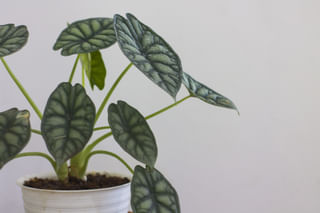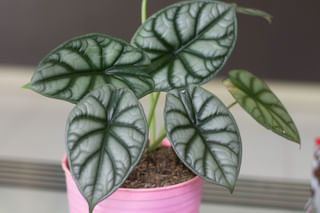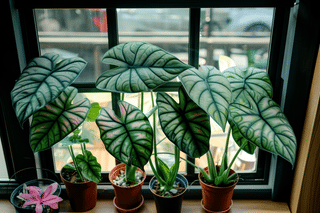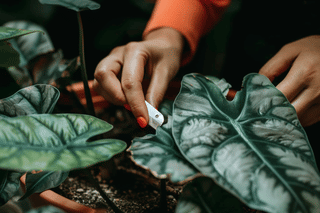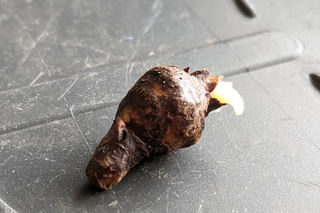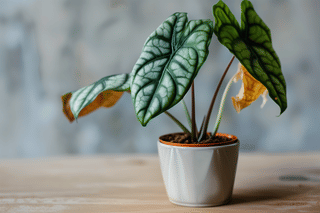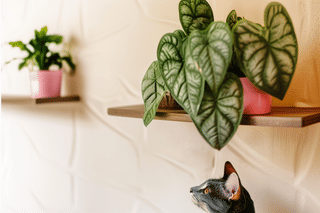How to care for an Alocasia Silver Dragon
Learn how to take care of your Alocasia Silver Dragon plant with this easy-to-follow plant care guide. In this plant care guide, you'll learn more about sunlight, water, fertilizer, and toxicity levels for your pets.
If you're a beginner plant owner, there's a good chance you've added an Alocasia Silver Dragon to your collection. This popular houseplant is quite easy to care for and has striking foliage. In this plant care guide, I'll walk you through the steps to take care of your Alocasia Silver Dragon so it stays happy and healthy.
These are the topics we're going to look at in this plant care guide:
Let's get started!
How often should I water my Alocasia Silver Dragon?
Alocasia Silver Dragons are tropical plants that love moist, humid environments. To keep your plant happy, make sure it has moist but not wet soil. You know it's time to water your Alocasia when the top inch of soil feels dry to the touch. On average, you should water your Alocasia Silver Dragon about once a week.
If your Alocasia Silver Dragon is having problems with overwatering, you will need to cut back on the amount of water that you are giving it. Make sure that the potting soil is completely dry before watering again. Overwatering can cause the roots to rot, and the plant may begin to yellow and wilt.
Alternatively, if the Alocasia Silver Dragon is not getting enough water, it may experience problems such as wilting, leaf drop, and stunted growth. Yellow leaves don't automatically mean you're dealing with a watering issue though. When leaves are getting older, they'll turn yellow as well. In this case, yellow leaves are no problem and you can just trim them off.
When watering your Alocasia, it's ideal if you've got a drainage hole in the bottom of the pot, because that helps you to drain any excess moisture from the pot. To help prevent root rot, let the excess moisture drain out of the pot for about 5 minutes after you've watered it. The soil should have drained the excess moisture from the pot after those 5 minutes.
How do I know if my Alocasia Silver Dragon is getting too much or too little water?
In this section, we'll look at reading signs of watering issues. By understanding the signs of over or under-watering, you can ensure your plant stays healthy in the long run.
Too much water
- Yellowing leaves: Yellow leaves are one of the first clues that something could be wrong. Too much water can suffocate the roots, preventing them from absorbing nutrients efficiently.
- Soft, mushy stems or roots: This is a sign of root rot, this is when roots are consistently too wet and start to rot.
- Stunted growth: Overwatering can lead to poor health and growth because the plant cannot uptake nutrients properly.
Too little water
- Drooping leaves: Alocasia leaves will droop when they're not getting enough water.
- Dry, crispy edges on leaves: This shows that the plant is not receiving enough water and it can't keep its leaves hydrated enough.
- Soil pulling away from the pot's edge: Dry, compacted soil is a clear sign the plant needs more water.
If you notice any of these signs, be sure to water your plant if it's too dry or wait to water until the soil is dry. If your plant is suffering from root rot, you might want to follow the tips I gave in How to rescue a plant from overwatering.
How much light does my Alocasia Silver Dragon need?
As with most tropical plants, Alocasia Silver Dragons need plenty of sunlight. The Silver Dragon needs bright, indirect light. This means the plant shouldn't get too much or too little light. Place your plant in a spot where it will get at least six hours of bright, indirect sunlight each day. Alocasia Silver Dragons need bright light but they can also tolerate some lower light levels for short periods.
Too little light will cause the leaves to become smaller and the plant to grow more slowly. If the plant is in an area that gets too much sunlight, the leaves will turn yellow and may die. If your Alocasia gets exposed to too much direct sunlight, it will cause sunburns on its leaves, so make sure that the sunlight is always indirect. You can place your plant behind a thin curtain or in a bright, but shaded spot in your house.
How do I know if my Alocasia Silver Dragon is getting too much or too little sunlight?
Figuring out whether your Alocasia is getting too much or too little sunlight can be a bit tricky, so here are all the signs your plant will show when it's not happy. This will help you to take better care of your plant.
Too much sunlight
- Scorched or sunburnt leaves: If the leaves look bleached, brown, or have crispy edges, your plant might be getting too much direct sunlight.
- Faded or washed-out leaves: Too much light can cause the vibrant colors of the leaves to fade to a washed-out color.
- Rapid soil drying: If the soil dries out much faster than usual, it might be due to too much heat from excessive sunlight.
Too little sunlight
- Leggy growth: The plant will look like it's stretching towards the sunlight. Your plant will have long stems with the leaves spaced far apart.
- Smaller leaves: Too little sunlight can cause new leaves to stay smaller than you'd be used to.
- Lack of growth: Without enough light, your Alocasia will grow much slower and stay small. Only with enough sunlight will the normal growth rate return.
If you notice any of these signs, make sure to move your plant to a brighter or darker spot, depending on the problem. The ideal spot is a bright spot that receives indirect sunlight. Of course, I don't know your exact climate, so you might need to experiment a little with the plant's location. Just pay close attention to any signs of trouble and you'll find the right spot.
The ideal temperature range for an Alocasia Silver Dragon
Alocasia Silver Dragon is a tropical plant and to make sure it thrives, it's important to try to mimic its natural habitat as much as possible. Here are the ideal temperature conditions for this plant:
- Daytime temperature: During the day, Alocasia Silver Dragon prefers temperatures ranging from 18 to 27 degrees Celsius (65 to 80 F).
- Nighttime temperature: At night, a slight drop in temperature is fine, but it should not fall below 15 degrees Celsius (60 F). If the temperature is consistently below this level it can stress the plant and lead to health issues.
- Avoid temperature extremes: Sudden temperature changes or exposure to temperatures outside of the ideal range can cause stress to your Alocasia Silver Dragon. Avoid placing your plant near air conditioning vents, heaters, or drafty windows, as these can cause "extreme" temperature changes.
Humidity requirements for an Alocasia Silver Dragon
Humidity also plays a big role in keeping your Alocasia Silver Dragon healthy. These plants thrive in high-humidity environments, ideally between 60% and 80%. So, if your home's air is too dry, you can try using a humidifier.
A few low-tech solutions are placing the plant on a pebble tray with water, placing your Alocasia near other plants to create a mini-humid environment, or misting your plant to increase the surrounding humidity.
If you're unsure what the current humidity levels are, you can use a hygrometer to monitor the humidity levels in your plant's environment. This is a huge help to ensure the levels stay within the ideal range for your Alocasia Silver Dragon's health and growth.
When the humidity is too low, you might notice signs of stress on your Alocasia Silver Dragon, such as crispy tips on the leaves or limp foliage. These are signs that the air around your plant is too dry and that humidity levels need to be increased.
The best type of soil for an Alocasia Silver Dragon

When choosing the right soil for your Alocasia Silver Dragon, there is only one thing you'll need to look out for: how well it drains excess moisture. This plant prefers moist, well-drained soil. But what does this mean? Let's break it down!
Moist, but well-draining soil is a mixture that holds onto moisture for a few days and drains any excess soil to the bottom of the pot. This is perfect for a tropical plant like this Alocasia, as it likes the moist soil, but is also prone to root rot if it's in soil that's too wet.
You can make your own potting mix by combining equal parts peat moss, perlite, and general potting soil. This mixture will provide all the requirements for keeping your Silver Dragon healthy. The potting soil will hold onto moisture and help to feed your plant. The perlite helps to keep the soil aerated allowing any excess water to drain quickly. Peat moss is a favorite for acid-loving plants, perfect for your Alocasia Silver Dragon!
If you don't want to make your own mix, you can purchase a pre-made houseplant potting mix from your local garden center. Just make sure it's mixed specifically for tropical houseplants.
Fertilizing an Alocasia Silver Dragon
All plants need to be fertilized at some point, some plants just need more of it than others. Alocasias are generally quite hungry plants because they like to grow quickly and produce many (large) leaves. Fertilizing an Alocasia Silver Dragon helps the plant to grow larger leaves with more color and better overall health.
Fertilize your plant in the spring and summer around every 2-3 weeks using a balanced 10-10-10 houseplant fertilizer. The easiest type of fertilizer is a liquid fertilizer, as you can mix this in with the water you'll use to water your plant. Make sure to follow the directions on the fertilizer package, as too much fertilizer can damage the plant.
In the fall and winter, when growth slows down, you shouldn't fertilize your Alocasia. During this time of the year, your plant will be resting and won't grow as much. This also means that it won't need or use any fertilizer. If you still fertilize your plant during this time, it could lead to overfertilizing, which can damage your plant's roots.
Pruning an Alocasia Silver Dragon
When it comes to your Alocasia Silver Dragon, giving it a little trim is key for its well-being and growth. Focus on snipping off any tired-looking leaves to help the plant put its energy into fresh growth and keep looking its best.
Here are some key points on how to prune your Alocasia Silver Dragon effectively:
Timing
Spring or early summer is the perfect time for pruning. It's when plants are growing, so trimming off what's not needed won't stress them out. Just a tip: avoid winter pruning since plants usually take a break during the colder months.
Tools
Make sure to always use sharp and sterilized pruning tools. This precision not only helps avoid harming the rest of the plant but also lowers the chances of spreading diseases.
Technique
When pruning, cut close to the base of the stem of the leaf you are removing, but leave a small portion of the stem intact to avoid damaging the main plant. Be cautious not to remove more than 25% of the foliage at a time. Over-pruning can stress the plant and slow down its growth.
Post-pruning care
After you prune, take a good look at your plant for any hidden pests or diseases. You could also freshen up the soil or tweak your care routine to keep your plant happy and thriving!
Rehabilitation
If you're nursing back to health a really sickly Alocasia Silver Dragon, you might have to snip off the fully dead leaves and consider switching up the soil. A nice rinse and spray for the whole plant could also do wonders, cleaning up those roots and leaves to get it ready for a fresh beginning.
Pruning not only helps to remove unhealthy parts but also stimulates new growth. It's a natural part of the plant's lifecycle, so why not help your plant out a little by doing the work for them?
Growing flowers on an Alocasia Silver Dragon
It takes about six weeks for the Alocasia Silver to grow flowers. The plant typically grows flowers when it's extremely happy in its environment, with the right amount of water and sunlight. The flowers will begin to bloom during the Spring and Summer months. The Alocasia Silver Dragons flowers generally don't stay around for very long. They're usually gone after a week or so, after which you can prune them off.
Repotting an Alocasia Silver Dragon
When it comes to your Alocasia Silver Dragon, repotting is a big deal to keep it happy and thriving for many years. I recommend repotting your Alocasia once every 2-3 years but keep an eye on how it's growing and adjust as needed. Watch out for signs like roots peeking out, soil drying too quickly, or your plant getting a bit top-heavy and falling over.
When you think it's time to repot your Alocasia, you can follow the steps below for the best result.
Here's how you can repot your Alocasia Silver Dragon:
Choose the right time
The ideal time for repotting is during late spring or early summer when the plant is in its growth phase. Doing it then helps the plant bounce back faster from the repotting process.
Select an appropriate pot
Go for a pot that's about 2-3 inches bigger than the one you've got. Just make sure it's got those drainage holes to keep your plant happy and avoid any root issues with too much water.
Prepare the soil mix
For Alocasia Silver Dragon, you'll want a soil mix that drains well. Try a mix of potting mix, peat moss, and perlite in equal parts - it gives the right balance for healthy root growth, offering both moisture retention and good drainage.
Gently remove the plant
When you're ready to repot your Alocasia, gently take it out of its current pot. Be careful not to harm the roots. Give the pot a tap or a gentle squeeze to loosen the soil and roots.
Inspect and trim the roots
After you take the plant out of the pot, check the roots for any problems like disease or rot. If you spot any damaged or super long roots, snip them off with clean scissors or pruning shears.
Repot
Place a layer of the soil mix you prepared at the bottom of the new pot. Pop the plant right in the middle and fill around it with more of that soil mix. Just make sure the plant sits at the same level as it did in its old pot. Give the soil a gentle pat around the plant to keep it nice and supported.
Water thoroughly
After you repot, make sure to give the plant a good watering to help the soil settle around the roots and get rid of any air pockets.
Propagating an Alocasia Silver Dragon
Propagation is a great way to keep your plant healthy, and it gives you free plants in the process! Your Alocasia Silver Dragon can also grow better with propagation. Unfortunately, you can't propagate your Alocasia Silver Dragon from leaf cuttings, but there are two other methods for propagating your Alocasia; by division or by "seeds".
Division
- To propagate by division, carefully remove the plant from its pot and divide it into two or more sections.
- Each section should have at least one root ball and one set of leaves.
- Plant the sections in their pots and water them well.
- This method is by far the easiest way to propagate your Alocasia and works for almost all types of Alocasias, not just the Silver Dragon.
Seeds
- To propagate from seed, you'll first need to get the "seeds". These seeds are small bulbs that grow on the parent plant. Harvesting these looks a lot like propagation by division, but works slightly differently.
- Cover the seeds with a thin layer of vermiculite or potting soil and place the pot in a warm, bright location.
- Keep the soil moist but not wet and wait for the seeds to germinate, which can take anywhere from two to eight weeks.
- Once the seedlings have emerged, transplant the seedlings into their own pots when they are large enough to handle.
Propagating any Alocasia is quite easy and can be done once per year. So if you don't succeed on the first try, you can try again next year!
Common pests that affect the Alocasia Silver Dragon
If you thought these plants were immune to pests, I have bad news. Out of all the plants I've taken care of, the Alocasia is the most prone to pests. But don't let that scare you, they're also incredibly tough plants and so far have survived all infestations.
Let's see some of the pests you might find on your Alocasia Silver Dragon:
Spider Mites
Small bugs that can be reddish-brown and may create fine webbing. Look under the leaves. If you see light dots, your plant might have spider mites.
Aphids
Tiny insects, usually green or black. They like to be on fresh leaves or under older leaves. They leave a sticky liquid called honeydew.
Mealybugs
They look like small cotton pieces. They like to hide where leaves grow from the stem or under the leaves.
Scale Insects
They look like small brown bumps on stems or leaves. If leaves turn yellow and fall, scales might be the cause.
Fungus Gnats
Fungus gnats are small flies around the plant or in the soil. They are not a direct problem for the plant but are usually a side-effect of soil that's too wet.
Treating these pests can be quite time-consuming, but luckily, it's not very difficult. If you'd like to learn how you can treat every one of these pests, have a look at The 7 most common houseplant pests and how to control them.
Is an Alocasia Silver Dragon safe for pets?
Like many other Alocasia plants, the Silver Dragon is very toxic to both humans and pets. The sap will cause skin irritation and, if ingested, vomiting and diarrhea. If your pets or small children are generally curious about your plants, it's best to keep this plant out of reach. If you notice that your pet has chewed on this plant's leaves or stems, make sure to call your veterinarian to get advice on what to do to help your pet.
Moving an Alocasia Silver Dragon outside during the summer
If you want to move your Alocasia outside during the summer, you need to live in a climate that's warm enough during the summer and especially during the night. During the warmer months, you can take your Alocasia Silver Dragon outside, but you should keep a few guidelines in mind. When you move your Alocasia Silver Dragon out, here are a few care tips to keep in mind:
Temperature & sunlight
The temperature has to stay between 18 to 27 degrees Celsius (65 to 80 F) during the day and above 15 degrees Celsius (60 F) during the night.
Place the plant in a spot where it will receive bright but indirect sunlight. The plant won't have a window to shield it from direct sunrays, so make sure to prevent exposing it to the hot afternoon sun directly.
Rain & watering
If you live in a dry climate, you will have to water your plant more often than you would if it were growing indoors, because the moisture evaporates much more quickly outside. Regularly check if the soil is dry and needs water. If you live in a very wet climate, make sure your plant doesn't drown in the rainwater. A pot with a drainage hole is very important here. Trust me, I've accidentally used pots without a drainage hole outside and drowned several plants by doing so.
Take your time
And last, but not least, make sure to gradually move your plant outside over 2 weeks. On day 1, keep your plant outside for an hour and gradually give it more outdoor time. After 2 weeks you can keep your plant outside until the temperature goes below 15 degrees Celsius (60 F) during the night at the end of summer.
Winter care for an Alocasia Silver Dragon
Taking care of an Alocasia Silver Dragon in the winter means tweaking its care routine to keep it healthy in the colder, less sunny months. Here are a few things to keep in mind for winter care:
Light
In winter, when the sunlight is less bright, make sure to give your Alocasia Silver Dragon plenty of indirect light. Just move your plant to the brightest spot in your house. During summer, that light might be too intense, but in winter, it's just right! If you feel like your Silver Dragon needs more light, think about adding a grow light to help out during the shorter daylight hours.
Watering
During winter, the Alocasia Silver Dragon needs less water because evaporation rates are lower. Just check if the top layer of soil is dry before watering. You might only have to water it every 2 weeks in winter. Remember not to overwater, as the plant grows slower now and too much water can cause root rot.
Humidity
Indoor heating can lower the humidity in your home, which might not be great for your Alocasia. You could try using a humidifier or placing a water tray near the plant to up the humidity levels. Giving the leaves a little mist can also help, just watch out not to go overboard, especially in cooler temps to steer clear of any fungal problems.
Feeding
Hold off on fertilizing during winter when plants grow slower. Too much fertilizer can harm the roots. Just wait until spring to start feeding them again.
Conclusion
In this plant care guide, we've looked at how we can take care of an Alocasia Silver Dragon in your house! To keep your plant happy, you should make sure your Alocasia stays moist, has plenty of indirect sunlight, and is planted in well-draining, organic soil. By following these simple care instructions, you can enjoy your Alocasia Silver Dragon for many years to come!
Make sure to share this guide with your friends and family so they can learn how to take care of houseplants too! Thanks for reading this plant care guide.
If you have any questions, don't hesitate to reach out to me or ask the members of the Plant care for Beginners Facebook Group for help!
Thank you for reading this post! I hope it helps you to keep your plants healthy and beautiful! If you're looking for more guides on specific plants, you can always request a plant guide to get a guide for the plant you have trouble with.
Test your plant care knowledge
Quiz completed!
Want to learn more? Sign up for my newsletter to receive free tips in your inbox!
Sign up now!